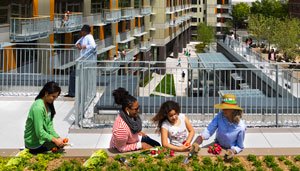
Supporting a range of housing types in compact development patterns, leveraging green design and construction standards and facilitating access to varied transportation options are all smart growth approaches that can help promote safer, healthier and more affordable communities.
On this page:
Communities across the United States are facing an increasing shortage of housing. This is driven, in part, by a lack of neighborhoods with diverse housing types, including smaller homes, townhomes, multi-family units and accessory dwelling units. Meanwhile, conventional housing development patterns have led an increased conversion of rural and natural lands and significant increases in vehicle miles traveled. This large-lot, dispersed housing development challenges local governments' ability to finance and maintain infrastructure like schools, utilities, street networks, and police and fire protection and preserve air and water quality.
By creating neighborhoods with a variety of housing options, communities can increase the amount of housing at different price points. Local land use policy and development regulations often make it difficult for developers and communities to provide diverse types of housing, but housing affordability strategies and investments, as well as inclusive policies for zoning and planning, can help.
One concern about walkable neighborhoods is that shifts in consumer preferences may lead to higher market value costs. Communities can lower the costs of these neighborhoods over time by changing zoning codes to make smart growth neighborhoods and a range of housing options easier and cheaper to build. This benefits all community members and mitigates housing instability and displacement for low-income or underserved residents.
Communities can also reduce the overall cost of living for residents by helping to reduce transportation and utility costs. Building housing near existing community destinations (e.g. libraries, schools, transit services, offices, shops, etc.) and investing in accessible transportation solutions can create neighborhoods that are walkable, safer and less expensive for commuting. When dispersed housing cannot support viable public transit, biking, or pedestrian options, automobile ownership becomes almost a necessity. The true cost of housing, therefore, is the combined cost of housing and transportation, since they generally make up the first and second largest household expenditures [ 1 ]. Today, nearly a quarter of rent households spend more than half of their incomes on rent each month, leaving little left to cover other essential expenses [ 2 ]. In addition, according to the Bureau of Transportation Statistics, lower income families spend on average 30 percent of after-tax income on transportation costs [ 3 ].
Green design approaches that reduce the energy and carbon impacts of new and existing homes can also help residents save on utility costs. Green building materials, techniques, and appliances can dramatically reduce energy consumption as compared to conventional approaches and can also improve environmental outcomes. ENERGY STAR-certified buildings, for example, use less energy and generate 35% fewer greenhouse gas emissions than typical buildings.
More efficient use of water also reduces a household's utility costs and reduces demand, which is vitally important in regions that are growing rapidly yet also suffering from drought. As climate change is projected to increase drought in many areas of the United States, water-efficient development will become even more important. Green building approaches also often contribute to improved indoor air quality.
Homes that use energy and water efficiently can help lower- and moderate-income households cope with economic impacts related to climate change, which could include volatile energy and water prices and supplies. As part of our adaptation to climate change, homes that maintain habitable conditions in extreme heat or cold and during power outages, are crucial to protecting their inhabitants.
This list includes relevant resources from EPA and federal agency partners that further explore the intersecting issues of housing development and the environment.
1 Bell-Pasht, Aimee. Low-Income Households Spend Nearly 20% of Income on Home Energy and Auto Fuel Costs. ACEE, 2024.
2 Airgood-Obrycki, Whitney, et al. The Rent Eats First: Rental Housing Unaffordability in the US. Joint Center for Housing Studies of Harvard University, 2021.
3 Bureau of Transportation Statistics. The Household Cost of Transportation: Is it Affordable? United States Department of Transportation, 2024.